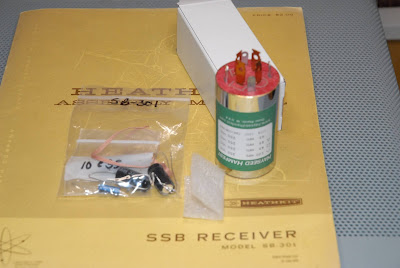Having gotten the downstairs Electronics Bench cleaned up, I decided to get cranked up again and get some things done after my usual mid-winter slump.
I was going to start on my Drake R4-B after spending several hours digging out my stash of Drake parts, but since I'm a bit rusty, I figured it would be better for all concerned if I started on the Heathkit SB-301 first.
Sorry for the crummy pix. Looks like my Indoor Photography skillz have tarnished a bit, too.
Why this one? Well, a year or so before we moved here I rebuilt it's stablemate, the SB-310 Shortwave version of this, which is better than 90% identical to this one. Same tubes, same resistors and capacitors, same alignment procedure, etc. It differs only in the Heterodyne Crystals used to determine it's frequency coverage.
In other words, I've been here, and done this, so it should be easy-peasy.
And I've got out my trusty EICO 667 "Dynamic Conductance" tube tester:
With both manuals:
Yes, I know how to "use" my tube tester, but it's way overdue that I sit down with the manuals and get to understand the tube tester. A quick check through the charts and a look at the sockets on it confirms that it will test any tube I currently use, or have in stock. I figured it would test the 6146 Power Amplifier tubes in the matching transmitter to this radio, but didn't really know until I looked at the tube listings. And a check of the front panel shows it will fit the Compactron tubes I use, and also Octal and Loctal tubes, which I don't.
And we have all the required replacement parts (less tubes) on hand:
If I need any tubes, I should have them, as I have two sets of "spares" for the SB-310. My criteria has been to reject tubes that read less than 85% on the tube tester. Is this valid? It's just something I've always done, but one of the reasons I want to RTFM for the tube tester. It has quite a good "How It Works" section, explaining how each measurement it's capable of making is made, and what the implications of the measurement are.
So next up is to pull the tubes and read the tube tester manual while I go through them. After that I'll pull the chassis from the cabinet and clean it, and start doing things like cleaning the controls and switches, checking how well it's put together, tightening all the hardware, and doing some other basic checks to bring this back to life.






I always liked the old Heathkit stuff. For the price and time to build, they were every bit as good as any High End Collins stuff IMHO.
ReplyDeleteThe SB series really was close to a Collins clone. Many of the same design details, like the crystal-controlled 1st conversion oscillator, the use of a discrete part for the I.F. filter, and a highly linear Master Oscillator. Heath used a crystal filter, while Collins used their own mechanical filters. The Collins Master Oscillator was permeability (Inductance) tuned, while Heath used a more conventional Capacitance tuned unit, supplied as a fully built, tested, aligned, and linearized sub-assembly.
ReplyDeleteI think I spent about a week building mine, and just went with the alignment procedure in the manual. This time I have much better test equipment than was even a dream in NASA's eye in 1965!
RTFM is a GOOD way to 'start'... Not after the fact...LOL
ReplyDeleteANNNNND it turns out I was NOT using the tube tester properly!
DeleteBoy, do *I* have a red face, or what?
After RTFM, and comparing the tubes in the set with a some NOS tubes, one of the 6AU6 tubes was "weak", testing at about 80%, a bit below my rule-of-thumb. Seeing as I have 25 NOS tubes ("JAN" tubes, no less), I tagged the weak one and replaced it.